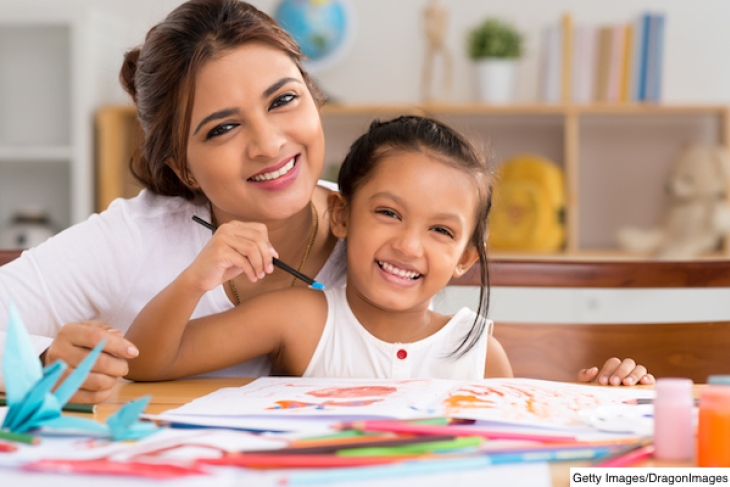Five-year old Carlo absorbs every Weather Channel special on tornados and then draws his own, very accurate scenarios. Gillian never holds still and naturally creates her own choreography, even when entering a room. Izzy makes up elaborate stories. Music seems like a second language for John.
You may have seen similar signs that your child is gifted in the arts. However, for many children, their artistic gifts may not be apparent until opportunity or exposure provides a spark. That’s why it’s important for parents and caregivers to understand the many ways they can ignite sparks, nurture artistic talents, and provide opportunities for gifted children to explore the arts.
Opportunity
In some schools, the arts may be viewed as less important or eliminated altogether. While the recent inclusion of the arts education in the Every Student Succeeds Act is encouraging, it’s important for parents and families to support the exploration and develop of artistic talent outside of schools.
In many communities, opportunities outside of![]() school abound. Local art museums, galleries, and university arts programs often provide summer and year-round classes, access to professional artists and mentors, and links to other interesting programs. Children can also find inspiration by visiting their library to read high-quality art books or biographies on famous artists. Contests are often advertised in local newspapers, online, and in local community outlets.
school abound. Local art museums, galleries, and university arts programs often provide summer and year-round classes, access to professional artists and mentors, and links to other interesting programs. Children can also find inspiration by visiting their library to read high-quality art books or biographies on famous artists. Contests are often advertised in local newspapers, online, and in local community outlets.
When looking for outside programs, parents should look for those that emphasize the processes of creating art, including both skill development and creativity, rather than a polished final product. In addition, parents should be patient in allowing time and practice for talents to emerge, and encourage children to persevere, looking for incremental improvements rather than perfection.
A Special Space
Artists, no matter what age, need a space of their own to experiment, practice, and discover. A dedicated place not only provides an emotionally safe place to create, but also manages some of the “noise and messiness” without inhibiting creativity. The special space can be a designated room, but a table, desk, easel, or portable basket with artistic supplies works, too. To accommodate young painters, parents might consider covering their basement or garage floor with drop cloths, so that paper, paints, and brushes are nearby for when the mood strikes.
Materials
Materials are essential for children to explore new ideas, and they don’t need to be purchased or expensive. There are magical powers in the plain cardboard box! Some of the most interesting artwork, musical instruments, and stage sets have been made from inexpensive collections of recycled materials or “costumes” from a thrift store. Smartphone and tablet applications are becoming more accessible for making movies, creating designs, or composing music.
Kindred Spirits
Participating in a community of artists is also an important component in the development of artistic talent. This may come in the form of an advanced art class in secondary school, an ensemble performance group for state music competitions, or a community theater production. It may be a special residential or day-school summer program in which children find others like themselves. By identifying a social circle to support creative endeavors, children are able to learn from each other, receive encouragement, and, perhaps most importantly, have the opportunity to develop social skills and deep friendships.
Supporting the Arts
Parent voices can be very influential. To support and advocate for arts programs at the local level, parents can:
- Show support for arts programs by attending concerts, art shows, and theatre productions.
- Get to know the arts teachers.
- Donate funds, materials, or time. School administrators or arts teachers will tell you what they need, if asked.
- Purchase products customized with their children’s artwork to fundraise for art supplies. Some art teachers post and document students’ work on the online gallery Artsonia, where parents can view and purchase various items that showcase their child’s artistic creations.
- Become more involved in the boards of parent organizations and their children’s schools.
- Keep in touch with school leaders and policymakers and let them know how much the arts matter.
Ultimately, there is strength in numbers. In addition to nurturing their own child’s passions, parents can also support artistically gifted children by joining other parents, teachers, professionals, and university professors in NAGC’s Arts Network.
Dr. Hope E. Wilson is an associate professor at the University of North Florida and past chair of the NAGC Arts Network. Dr. Clar M. Baldus is a clinical associate professor at the University of Iowa and chair of the NAGC Arts Network.
Editor’s Note: A version of this post appeared in Parenting for High Potential (December 2016).
